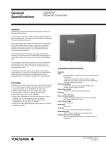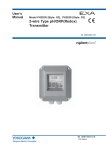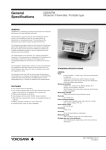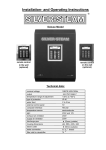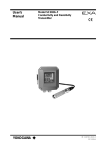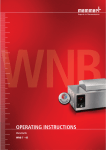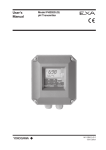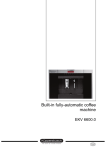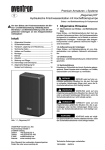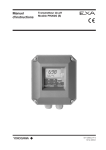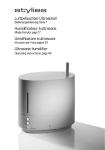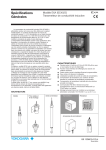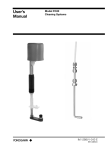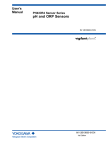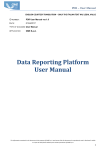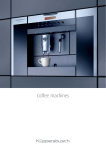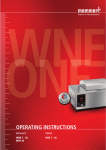Download User`s Manual - Applied Measurement and Control
Transcript
User’s Manual Model PH18 Differential pH sensor IM 12B6J4-E-A 1st edition (Rev. 4th edition H) TABLE OF CONTENTS PREFACE...........................................................................................................................1 1.INTRODUCTION ............................................................................................................3 2.GENERAL SPECIFICATIONS ........................................................................................5 2-1. Model PH18 differential pH sensor............................................................................5 2-2. Model WU18 cable for PH18 sensor ........................................................................6 2-3. Dimensions of the PH18SA ......................................................................................7 3.THE TYPE 18 PH PROBE..............................................................................................8 3-1.Typical applications ..................................................................................................8 3-2.Handling information for the glass lined pH probe ....................................................8 3-3.Storage and hydration ..............................................................................................8 3-4.Installation ................................................................................................................8 3-5.PH18 Installation examples ......................................................................................9 4.EXA PH202 OR PH402 INSTRUMENT ......................................................................10 4-1.Set-up ....................................................................................................................10 5.CALIBRATION ..............................................................................................................11 5-1.Calibration set-up....................................................................................................11 5-2.Isopotential pH value ..............................................................................................11 5-3.SLOPE ..................................................................................................................11 5-4.ASY ........................................................................................................................11 5-5.Process Temperature compensation ......................................................................11 6.CLEANING/STERILIZATION ......................................................................................12 6-1.Acceptable CIP cleaning processes........................................................................12 6-2.Sterilization methods ..............................................................................................12 7.MAINTENANCE............................................................................................................12 8. POSITION OF THE O-RINGS ......................................................................................13 9.ACCESSORIES ............................................................................................................13 APPLICATION DATA SHEET PH DIFFERENTIAL PH SENSOR ..................................14 IM 12B6J4-E-A Caution - Inappropriate handling can cause damage. Striking or scratching the sensor against hard surfaces such as steel, stone, glass or ceramic, may cause damage to the enamel. Such damage may not affect the sensor performance immediately, but after prolonged exposure to the process, flaking of the enamel may occur. Note - Enable impedance checks in the PH202 or PH402 The sensor impedance checking can give early warning of damage to the enamel layers. If the transmitter signals an impedance failure of the PH18, the sensor should be removed from the process, as soon as possible (within 24 hours). The loss of significant amounts of enamel may thus be avoided. IM 12B6J4-E-A 1 PREFACE The PH18 should only be used with equipment that meets the relevant IEC, American or Canadian standards. Yokogawa accepts no responsibility for the misuse of this unit. The PH18 is packed carefully with shock absorbing materials, nevertheless, it may be damaged or broken if subjected to strong shock, such as if the package is dropped. Handle with care. Although the PH18 has a weatherproof construction, the connections can be harmed if it becomes submerged in water or becomes excessively wet. Do not use an abrasive in cleaning the PH18. Notice Contents of this manual are subject to change without notice. Yokogawa is not responsible for damage to the sensor, poor performance, or losses resulting from such, if the problems are caused by: 1. Incorrect operation by this user. 2. Use of the sensor in the wrong applications. 3. Use of the sensor in an adverse environment or incorrect utility program 4. Repair or modification of the sensor by an engineer not authorized by Yokogawa. Warranty and service Yokogawa products and parts are guaranteed free from defects in workmanship and material under normal use and service for a period of (typically) 12 months from the date of shipment from the manufacturer. Individual sales organisations can deviate from the typical warranty period, and the conditions of sale relating to the original purchase order should be consulted. Damage caused by wear and tear, inadequate maintenance, corrosion, or by the effects of chemical processes are excluded from this warranty coverage. In the event of warranty claim, the defective goods should be sent ( freight paid) to the service department of the relative sales organisation for repair or replacement (at Yokogawa discretion). The following information must be included in the letter accompanying the returned goods: 1. Part number, model code and serial number. 2. Original purchase order and date. 3. Length of time in service and a description of the process. 4. Description of the fault, and the circumstances of failure. 5. Process/environmental conditions that may be related to the installation failure of the device. 6. A statement whether warranty or nonwarranty service is requested. 7. Complete shipping and billing instructions for return of material , plus the name and phone number of a contact person who can be reached for further information. Returned goods that have been in contact with process fluids must be decontaminated/disinfected before shipment. Goods should carry a certificate to this effect, for the health and safety of our employees. Material safety data sheets should be included for all components of the processes to which the equipment has been exposed. Unpacking and checking Upon receipt of the goods, carefully inspect the shipping package for any evidence of damage. If the carton is damaged, notify the shipping agent and the sales organisation immediately. If the shipping package is not damaged, remove the products and parts. Confirm that all items shown on the packing list are available and that the package does not contain any parts or accessories fillers. Notify the sales organisation if items are missing. PH18 sensor The box of the PH18 sensor contains the following items: Sensor complete, possible options (check part number for possible options), instruction manual, material certificate and quality inspection certificate. The WU18 cable is packed separately. IM 12B6J4-E-A 3 1. INTRODUCTION The PH18 is not a conventional electrode. It relies on two dissimilar ion sensitive enamel membranes to generate the signal. The measuring element is like a pH electrode, and the reference like a Sodium ion electrode. Therefore the PH18 can only be used in combination with pH meters that feature: 1 Dual high impedance inputs 2 Adjustable setting for Isothermal Point 3 Adjustable temperature coefficient The Yokogawa models PH202 and PH402 satisfy these requirements. In both cases the membrane enamels are bonded directly to the metal substrate with no filling solution. The response curves Fig. 1 (pH), Fig. 2 (reference) and Fig. 3 (application range) show the way in which the potential is generated at each element and combined in the output of the sensor. Fig. 1 Above pH11 the effect of sodium on the pH membrane starts to cause non-linearity (Sodium error) Fig. 2 Below pH3 the high Hydrogen ion content causes a change in the reference response Fig. 3 A linear response to pH is obtained between 3 and 11 pH Fig. 4 A plot of reference voltage against Sodium content. Because of the exponential nature of the response, it is plain that above about 0.5 N Na+ (30 g NaCl/l) in the solution, the reference output remains virtually constant. Of course when the Sodium concentration remains constant in a process the reference voltage will also be constant at much lower levels of Sodium. It is because of the need to evaluate the chemistry of the process, that it is necessary to have an Application Data Sheet (page 16) completed before approval for this sensor can be made. The mechanical construction of the sensor also means that it may be used in processes involving both high temperatures and pressures. By eliminating the filling solutions, the sensor is truly robust and can even withstand severe thermal shocks that would ruin most systems. The stainless steel mounting adapter forms the liquid earth (solution ground) connection needed to ensure best stability of measurement. EXA also uses this connection in the diagnostic circuit. The PH18 is a differential pH sensor. It does not measure absolute pH except in limited applications. It does, however, measure a single control point accurately, repeatably and with minimum maintenance The revolutionary measuring principle has some big advantages. The absence of filling solutions and reference junctions virtually eliminates the problems caused by aging and pollution of the reference sensor. Regular cleaning of the sensor virtually eliminates drift, and the sensor benefits from a very long working life. It is vital, however, to fit the sensor to the application correctly. The special nature of the reference element dictates that there must be a certain Sodium level in the process. Fig. 4 shows a plot of reference voltage against Sodium content. IM 12B6J4-E-A 4 Measuring Enamel mV vs. pH in solution containing 0.1N Na+ Operating range pH of sample Fig. 1 Reference Enamel mV vs pH in solution containing 0.1N Na+ Operating range pH of sample Fig. 2 PH18 system output pH reading vs. pH in solution containing 0.1N Na+ Operating range pH of sample Fig. 3 Reference Enamel mV vs Na + content Fig. 4 IM 12B6J4-E-A 5 2. GENERAL SPECIFICATIONS 2-1. Model PH18 differential pH sensor Temperature sensor : Pt1000 Ω RTD Wetted parts - pH sensor : pH sensitive enamel - Reference sensor : Na+ sensitive enamel - Liquid earth : via SS adapter - O-rings : EPDM - Adapters : SS 316 Max. measuring range : 3 to 11 pH (The actual range will be advised with reference to the completed application data sheet) Temperature range : 0 to 140 ºC (284 ºF) Pressure range : -1 to 15 Bar (214 psi) NOTE: The use of this sensor is highly application specific.Your local Yokogawa sales office will be pleased to advise on the suitability of your application, on receipt of the completed application data sheet. Any and all information received by Yokogawa will be treated in the strictest confidence. To maintain traceability, the completed application data sheet will form part of the contract of sale. Yokogawa offers no function guarantee for applications where the attached data sheet (page 16) has not been satisfactorily completed. This does not affect the normal Yokogawa warrantly covering defects in materials or workmanship. MODEL AND SUFFIX CODE Model PH18 Sensor mounting O-ring material Instruction manual Options SA Suffix Option Description code code ......................... Model PH18 Differential pH sensor -SA................... Compatible with 25mm ......................... process connection -E................. Ethylene-propylene (EPDM) -E................ -N............... /SWA.... /SWR... /SNS.... /SBS.... /BSA1.. English language No manual Angled weld-in adapter (SS316) Straight weld-in adapter (SS316) Adapter 1” NPT (SS316) Adapter ISO 7/1-R1, JIS 1”(SS316) Blind plug SS316 (EPDM O-ring) Note: The sensor is supplied with cable connector. For first installation cable must be specified as well. (see par.2-2) Note: The material certificate 3.1.B is supplied with the sensor and the options. IM 12B6J4-E-A 6 2-2. Model WU18 cable for model PH18 differential pH sensor Max. temperature : 110 ºC (230 ºF) Material : Thermoplastic Rubber (T.P.R.) Colour : Blue. Shipping details sensor and adapter - Package : wxhxd 350 x 220 x 110 mm - Weight : approx. 1.4 kg Shipping details cable - Package : wxhxd 350 x 220 x 110 mm - Weight : 2 m. approx. 0.6 kg : 5 m. approx. 0.9 kg : 10 m. approx. 1.4 kg MODEL AND SUFFIX CODE Model WU18 Suffix Option Description code code ......................... Cable for Differential pH Sensor -02 ................... 02 meter connection cable -05 ................... 05 meter connection cable -10 ................... 10 meter connection cable IM 12B6J4-E-A 7 2-3. Dimensions of the PH18-SA Fig. 5 PH18-SA and the adapters /SWR /SWA in mm (inches) Fig. 6 External dimensions of the PH18-SA /SBS /SNS /BSA1 Fig. 7. Options of the PH18-SA IM 12B6J4-E-A 8 3. THE TYPE 18 PH PROBE 3-1. Typical applications • Fermentation • Continuous reactions • Production of diary products • Product monitoring 3-2. Handling information for the glass lined pH probe. The differential pH probes are pressure and thermal shock resistant due to the fused steel/enamel construction. The probes have a very high mechanical stability and are extremely strong. Inappropriate handling, e.g. hitting and scratching the probe on steel, ceramics, glass or stone may cause damage to the probe. Depending on the scope of the damage, the probe may not fail immediately but rather when the temperature changes. If a defective measuring probe remains in aqueous solutions for prolonged periods of time enamel may flake. Enable the EXA impedance monitoring. If sensor damage is indicated, the measuring probe must be immediately removed (within 24h) after an alarm message. All probes for use in the food sector are tested with a voltage of 12 kV and conditioned for 5 hours in steam at a temperature of 134 °C. 3-3. Storage and hydration The PH18 Probe can be stored dry for an indefinite period of time at temperatures between -30 and +80 ºC. After prolonged storage or if this is a new probe from the factory a simple steam sterilization should be performed for 15-30 minutes prior to calibration. This procedure revitalizes the probes giving it a stable reference potential. If steaming is not possible soak the PH 18 for 45-60 minutes in hot water (65 to 85 ºC). If steaming or a hot soak can not be done, place the Probe in a standard pH7 Buffer solution for 24 hours prior to installation. The probe must be immersed so that both measuring elements are covered with buffer. IM 12B6J4-E-A 3-4. Installation Procedure: 1. Remove the probe from the packaging, remove the protective plastic hose and carefully introduce the probe into the nozzle. 2. Fasten probe with union nut 3. Connect cable. For this purpose, loosen the heavy gauge conduit connection at the protective plastic cover, push out the connector, put the connector in the proper position, and firmly press it into the female connector of the probe (water- tight interlock). Push the protective cover and O ring sealing onto the probe until the stop and tighten the heavy gauge conduit connection again manually. 4. The cable with high temperature stability (blue) must be fastened vibration free. The cable must not be laid together with power cables. Only suitable transmitters with symmetrical high impedance inputs may be used. The following units are approved: • Yokogawa EXA PH 202 • Yokogawa EXA PH 402 9 3-5. PH18 Installation examples Socket for connection cable Primary adapter pH enamel Reference enamel Fig. 11 The primary adapter is used to make a connection to the process used by the transmitter as the liquid earth (solution ground). This is needed for optimum stability of the measurement and is used in the impedance checking circuit. Example A. Straight weld-in adapter through a vessel wall. Example B. 1” Screw-in adapter with existing pipe nipple through a vessel wall. Example C. Angled weld-in adapter in large bore pipe. Example D. Angled weld-in adapter mounted in a bend Example E. Screw or weld-in adapter mounted in a large bore pipe. Example F. Screw or weld-in adapter mounted on top of a large bore pipe Fig. 12. Model 18 elements Note 1: When measuring in plastic tanks or pipes, ensure that the adapter is wetted by the process. Avoid installations where an air pocket can be created (see fig 12 F). This isolates the adapter, and hence loses the liquid earth connection. Note 2: Flow rate from the side of the sensor (Fig 11) should not exceed 2 meters/second in low viscosity fluids. In high viscosity fluids (> 5cP) use only installation as shown in Fig. 12 (D). IM 12B6J4-E-A 10 4. EXA PH202 OR PH402 INSTRUMENT 4-1. Set-up The EXA PH202 and PH402 are both designed with dual matched high impedance inputs which are necessary when using a pH probe like the Model PH 18 with both a measuring and a reference electrode that are high impedance. To prepare the EXA instrument to work with the PH18 make sure the input impedance jumpers are placed in the correct positions: PH202: See table 3-1 and fig. 3-8 on page 3-7 in the PH202 Instruction Manual (IM 12B6C3-E-H) for jumper positions. PH402: See figure 3-9a on page 3-8 in the PH402 Instruction Manual (IM 12B6B3-E-H) for jumper positions. Since the Model PH18 has high impedances for both the measuring and the reference elements, the high impedance check functions (Service Codes 03 & 04) must be set up according to the procedures outlined in Section 5.3.1 in either the PH202 or the PH402 Manual. The Calibration check also needs to be changed. Here you are instructed to set: Service Code 03: Change settings from 1.1.1 to 1.0.1 by using the ^ and > keys. Low limit 1Megohm. High limit 1 Gigaohm. Service Code 04: Change settings from 0.0.1 to 1.0.1 by using the ^ and > keys. Low limit 1Megohm. High limit 1 Gigaohm. Service Code 05: Change settings from 1.1 to 0.1 by using the ^ and > keys. This disables the As. Pot. check which is not appropriate for the PH18 system. Once the jumpers and impedance Service Codes (03 & 04), Calibration Check (05) and Temperature element have been set correctly, wire the probe cable to the instrument as shown in Fig. 13. Power wiring instructions are located in the respective instrument manuals: PH202: See section 3-4-3 on page 3-6 in the PH202 Instruction Manual (IM 12B6C3-E-H). PH402: See section 3-3-3 on page 3-5 in the PH402 Instruction Manual (IM 12B6B3-E-H). Measuring range MEASURE SCREEN SCREEN REFERENCE LIQUIDEARTH TEMPERATURE TEMPERATURE 1 2 Model PH18 sensor pH of sample Fig. 13 Connection diagram WU18 for PH402 and PH202 IM 12B6J4-E-A Fig. 14. Corrosion curve of the Model PH18 Enamel 11 5. CALIBRATION proper functioning of the sensor. 5-1. Calibration set-up All pH sensors are characterized by Isopotential (ITP), Asymmetry Potential (ASY) and SLOPE (SL). Typically the ITP is set by the factory for specific sensor types and the ASY and the SL are adjusted by the user during his buffer calibrations. Calibration of the PH18 is slightly different from calibration of conventional pH sensors due to the differential nature of the measurement. The ITP and SL are set during commissioning and ASY is adjusted by the user during his Grab Sample calibrations. 5-4. ASYMMETRY Potential The default setting for Asymmetry potential is 0 mV at Isopotential pH value. This value is always wrong for the PH18 sensor and therefore the Asymmetry Potential must be calibrated always. This cannot be done with conventional pH buffer solutions, since these buffer solutions will have salt compositions, which differ from the actual process. Therefore the calibration is done using the grab sampling method: During the most important stage of the pH control application a sample is drawn and the pH of the sample is measured with a calibrated conventional pH meter. The analyzer is adjusted to this value using the MAN.CAL mode. Notes: This adjustment should be done at the normal working temperature at the most important stage of the process (the control setpoint, or the critical part of the pH profile). This avoids the need for process temperature compensation for constant temperature processes. 5-2. Isopotential pH value The default setting for the Isopotential point is 0 mV at 7.00 pH, because most manufacturers of Glass electrodes use 7 pH as internal fill solution. The PH18 differential sensor has two measuring elements: one pH element which has an Isopotential pH value of 1 pH and one pNa element, which has an Isopotential pNa value of –2. The Isopotential pH value of the differential sensor depends on the Salt concentration. It is recommended to set the ITP as a function of the Conductivity according to the graph. 5-3. SLOPE The default setting for SLOPE is 100% of theoretical value, which is 59,16 mV/pH@25°C. It is only possible to calibrate the SLOPE, if pH buffers are used with identical salt concentration. These buffers are not commercially available, so it is recommended not to perform a SLOPE calibration, but leave the analyzer in its default settings. It is however recommended to perform a regular SLOPE check to verify 5-5. Process Temperature Compensation This setting is needed only when the temperature of the process is not (reasonably) constant. When setting process TC, it should be done before step 5-4. to avoid influencing the Asymmetry potential calibration. The procedure is as follows: Allow sensor to stabilize fully in the process. Note down the temperature and pH readings (t1 & pH1). Allow sample and sensor to cool (together) to room temperature, and stabilize. Again note down the temperature and pH readings (t2 & pH2) T.C. = (pH1-pH2)x10/(t1-t2) pH/10°C Note: to calculate TC from temperature readings in Farenheit, TC = (pH1-pH2)x18/(t1-t2) IM 12B6J4-E-A 12 6. CLEANING/STERILIZATION 7. MAINTENANCE The probe can be cleaned/sterilized inside the reactor. For CIP cleaning it must be ensured that the admissible alkali and acid concentration as well as the maximum temperature or cleaning time are not exceeded. Otherwise, the enamel of the electrode would be subject to increased corrosion. The PH18 does not normally require maintenance, as long as it is kept clean. Buffer checks may be done if it is suspected that the sensor performance has drifted appreciably. It is best, however, simply to do a single point “Manual” calibration against a grab sample taken at the process temperature and normal pH value. NOTE: With alkali cleaning, corrosion is doubled with every temperature jump of 10 ºC. The use of oxidizing acids, such as HNO 3, is limited to solutions of 1.5% at a maximum of 50 °C. 6-1. Acceptable CIP cleaning processes 1. 1.5 - 2% alkaline solution, max 85 ºC, max 1 hour. 2. 1.5% acid (HNO 3 ), 50 ºC, max. 15 min. 3. Steam 134 ºC, max. 2 hours After cleaning with alkaline solution without acid and steam sterilization, a transitional measuring error may occur if the wetting time is too short. 6-2. Sterilization methods The probe is resistant to the following sterilization methods: • with product • with steam • with alcoholic solutions • with antiseptic solutions IM 12B6J4-E-A For cleaning or removal of residues dilute acids may be used for a short time at room temperature only. Limescale may be removed with commercially available “antiliming” agents. The non-abrasive material intended for ceramic cookers may be used to remove sticky coatings from the PH18 Do not use any metallic or abrasive substances! 13 8. POSITION OF THE O-RINGS 9. ACCESSORIESl PH18 differential pH sensor Number K1500BJ PH18-SA K1500BR K1500BS K1500BT K1522ER K1522EQ K1522ET K1522ES K1522MV Size of the O-ring A= 17.12 X 2.62 B= 20.30 X 2.62 C= 25.12 X 1.78 D= 17.12 X 2.62 Description Q’ty Set O-rings 20.3 x 5 2.62 (EPDM) unit Set O-rings 17.12 x 2.62 5 (EPDM) unit Set O-rings 25.12 x 1.78 1 (EPDM) unit Nut 1 /SWR Straight 1 weld-in adapter /SWA Angled 1 weld-in adapter /SBS Adapter 1 ISO 7/1-R1, JIS 1” /SNS Adapter 1 1” NPT /BSA1 Blind plug 1 EPDM K1500BR K1500BJ K1500BS K1500BR IM 12B6J4-E-A 14 APPLICATION DATA SHEET PH18 DIFFERENTIAL PH SENSOR Yokogawa Confidential IM 12B6J4-E-A 15 IM 12B6J4-E-A 16 EUROPEAN HEADQUARTERS Yokogawa Europe B.V. Databankweg 20 3821 AL AMERSFOORT The Netherlands Tel. +31-33-4641 611 Fax +31-33-4641 610 E-mail: [email protected] www.yokogawa-europe.com THE NETHERLANDS Yokogawa Nederland B.V. Hoofdveste 11 3992 DH HOUTEN Tel. +31-30-635 77 77 Fax +31-30-635 77 70 AUSTRIA Yokogawa Austria Ges.m.b.H. Franzensbrückenstrasse 26 A-1021 WIEN Tel. +43-1-2165 043 0 Fax +43-1-2165 043 33 BELGIUM Yokogawa Belgium N.V./S.A. Minervastraat 16 1930 ZAVENTEM Tel. +32-2-719 55 11 Fax +32-2-725 34 99 FRANCE Yokogawa Contrôle Bailey S.A. Vélizy Valley 18-20 Rue Grange Dame Rose 78140 VELIZY VILLACOUBLAY Tel. +33-1-39 26 10 00 UNITED KINGDOM Yokogawa United Kingdom Ltd. Stuart Road, Manor Park, RUNCORN Cheshire WA7 1TR Tel. +44-1-928 597100 Fax +44-1-928 597101 GERMANY Yokogawa Deutschland GmbH Berliner Strasse 101-103 D-40880 RATINGEN Tel. +49-2102-4983 0 Fax +49-2102-4983 22 HUNGARY Yokogawa Hungaria Ltd. Galamboc u. 30 1119 BP Budapest Tel. +36-1-204 2797 Fax +36-1-204 2781 ITALY Yokogawa Italia S.r.l. Vicolo D. Pantaleoni, 4 20161 MILANO Tel. +39-02-66 24 11 Fax +39-02-645 57 02 SPAIN Yokogawa España S.A. C/Francisco Remiro, N°2, Edif. H 28028 MADRID Tel. +34-91-724 20 80 Fax +34-91-355 31 40 AUSTRALIA Yokogawa Australia Pty Ltd. Private mail bag 24 Centre Court D3 25-27 Paul Street North NORTH RYDE, N.S.W. 2113 Tel. +61-2-805 0699 Fax +61-2-888 1844 SINGAPORE Yokogawa Engineering Asia Pte. Ltd. 11, Tampines Street 92 SINGAPORE, 528872 Tel. +65-783 9537 Fax +65-786 2606 JAPAN Yokogawa Electric Corporation 2-9-32, Nakacho, Musashino-shi TOKYO, 180 Tel. +81-422 52 5617 Fax +81-422 52 0622 SOUTH AFRICA Yokogawa South Africa (Pty) ltd. 67 Port Road, Robertsham Southdale 2135, JOHANNESBURG Tel. +27-11-680-5420 Fax +27-11-680-2922 UNITED STATES OF AMERICA Yokogawa Corporation of America 2 Dart Road NEWNAN,GA 30265-1040 Tel. +1-770-253 70 00 Fax +1-770-251 28 00 CENTRAL/EAST REGION Via Yokogawa Austria: Czechia, Slovakia, Poland, Croatia, Slovenia, Jugoslavia, Bulgaria, Romania, Macedonia, Bosnia & Herzegovina Distributors in: Denmark, Finland, Greece, Norway, Portugal, Russian Federation, Sweden, Switzerland and Turkey. Block 02A, 01-99 IM 12B6J4-E-A Copyright © Subject to change without notice 04-904 (A) Q Printed in the USA


















